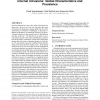17 search results - page 1 / 4 » Very Large Cliques are Easy to Detect |
83
Voted
DAGSTUHL
2006
15 years 1 months ago
2006
It is known that, for every constant k 3, the presence of a k-clique (a complete subgraph on k vertices) in an n-vertex graph cannot be detected by a monotone boolean circuit usi...
102
Voted
LREC
2010
15 years 1 months ago
2010
We present an experimental framework for Entity Mention Detection in which two different classifiers are combined to exploit Data Redundancy attained through the annotation of a l...
BMCBI
2007
15 years 11 days ago
2007
Background: Clustered Regularly Interspaced Palindromic Repeats (CRISPRs) are a novel type of direct repeat found in a wide range of bacteria and archaea. CRISPRs are beginning to...
101
click to vote
SIGMETRICS
2003
ACM
15 years 5 months ago
2003
ACM
Network intrusions have been a fact of life in the Internet for many years. However, as is the case with many other types of Internet-wide phenomena, gaining insight into the glob...
109
click to vote
RAID
1999
Springer
15 years 4 months ago
1999
Springer
: I will discuss two efforts to get Intrusion Detection Systems to work together - the Common Intrusion Detection Framework (CIDF), and the IETF's working group to develop an ...

